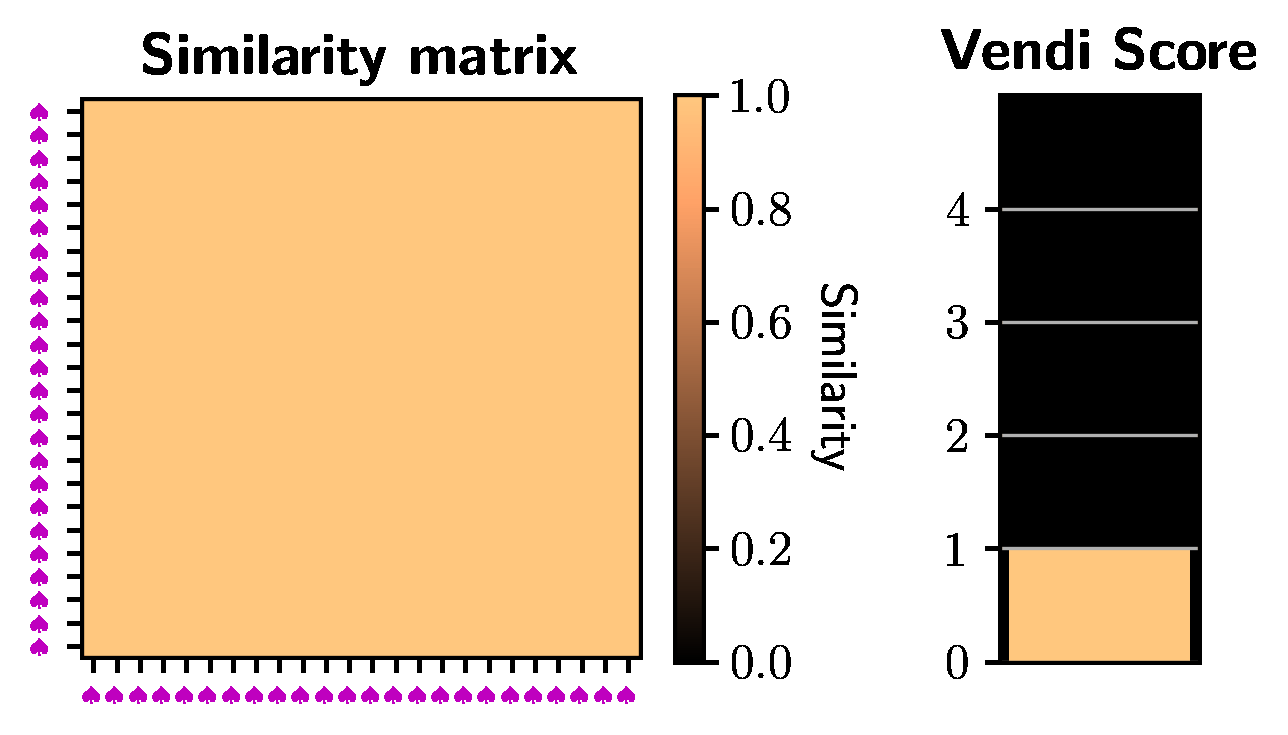This repository contains the implementation of the Vendi Score (VS), a metric for evaluating diversity in machine learning.
The input to metric is a collection of samples and a pairwise similarity function, and the output is a number, which can be interpreted as the effective number of unique elements in the sample.
Specifically, given a positive semi-definite matrix
The Vendi Score provides an accurate and interpretable measure of diversity
For more information, please see our paper, The Vendi Score: A Diversity Evaluation Metric for Machine Learning and our follow-up paper Cousins of the Vendi Score: A Family of Similarity-Based Diversity Metrics For Science And Machine Learning.
You can install vendi_score from pip:
pip install vendi_score
or by cloning this repository:
git clone https://github.com/vertaix/Vendi-Score.git
cd Vendi-Score
pip install -e .
vendi_score includes some optional dependencies for computing predefined similarity score between images, text, or molecules. You can install these dependencies with a command as in the following:
pip install vendi_score[images]
pip install vendi_score[text,molecules]
pip install vendi_score[all]
The input to vendi_score is a list of samples and a similarity function, k, mapping a pair of elements to a similarity score. k should be symmetric, and k(x, x) = 1:
import numpy as np
from vendi_score import vendi
samples = [0, 0, 10, 10, 20, 20]
k = lambda a, b: np.exp(-np.abs(a - b))
vendi.score(samples, k)
# 2.9999If you already have precomputed a similarity matrix:
K = np.array([[1.0, 0.9, 0.0],
[0.9, 1.0, 0.0],
[0.0, 0.0, 1.0]])
vendi.score_K(K)
# 2.1573One can also compute Vendi Scores of different orders
vendi.score(samples, k, q=1.)If your similarity function is a dot product between normalized
embeddings
vendi.score_dual(X)If the rows of normalize = True.
Some similarity functions are provided in vendi_score.image_utils, vendi_score.text_utils, and vendi_score.molecule_utils. For example:
Images:
from torchvision import datasets
from vendi_score import image_utils
mnist = datasets.MNIST("data/mnist", train=False, download=True)
digits = [[x for x, y in mnist if y == c] for c in range(10)]
pixel_vs = [image_utils.pixel_vendi_score(imgs) for imgs in digits]
# The default embeddings are from the pool-2048 layer of the torchvision
# Inception v3 model.
inception_vs = [image_utils.embedding_vendi_score(imgs, device="cuda") for imgs in digits]
for y, (pvs, ivs) in enumerate(zip(pixel_vs, inception_vs)): print(f"{y}\t{pvs:.02f}\t{ivs:02f}")
# Output:
# 0 7.68 3.45
# 1 5.31 3.50
# 2 12.18 3.62
# 3 9.97 2.97
# 4 11.10 3.75
# 5 13.51 3.16
# 6 9.06 3.63
# 7 9.58 4.07
# 8 9.69 3.74
# 9 8.56 3.43Text:
from vendi_score import text_utils
sents = ["Look, Jane.",
"See Spot.",
"See Spot run.",
"Run, Spot, run.",
"Jane sees Spot run."]
ngram_vs = text_utils.ngram_vendi_score(sents, ns=[1, 2])
bert_vs = text_utils.embedding_vendi_score(sents, model_path="bert-base-uncased")
simcse_vs = text_utils.embedding_vendi_score(sents, model_path="princeton-nlp/unsup-simcse-bert-base-uncased")
print(f"N-grams: {ngram_vs:.02f}, BERT: {bert_vs:.02f}, SimCSE: {simcse_vs:.02f}")
# N-grams: 3.91, BERT: 1.21, SimCSE: 2.81More examples are illustrated in Jupyter notebooks in the examples/ folder.
@article{friedman2022vendi,
title={The Vendi Score: A Diversity Evaluation Metric for Machine Learning},
author={Friedman, Dan and Dieng, Adji Bousso},
journal={arXiv preprint arXiv:2210.02410},
year={2022}
}@article{pasarkar2023cousins,
title={Cousins Of The Vendi Score: A Family Of Similarity-Based Diversity Metrics For Science And Machine Learning},
author={Pasarkar, Amey P and Dieng, Adji Bousso},
journal={arXiv preprint arXiv:2310.12952},
year={2023},
}